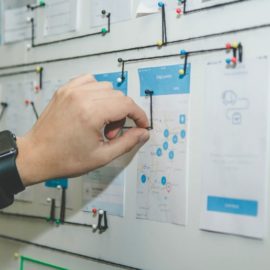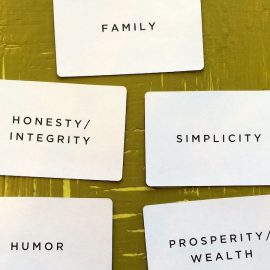

This article gives you a glimpse of what you can learn with Shortform. Shortform has the world’s best guides to 1000+ nonfiction books, plus other resources to help you accelerate your learning.
Want to learn faster and get smarter? Sign up for a free trial here .
What is holistic healing? What methods are beneficial for your mind, body, and soul?
Holistic healing is a non-traditional way to treat mental and physical conditions. Holistic healing methods—which don’t typically use pharmaceutical or surgical treatments—focus on caring for your physical, mental, spiritual, and social needs.
Check out several holistic healing methods that work outside the box when it comes to wellness.
1. Alpha State Visualization
You can use Alpha state visualization as a holistic healing method to improve your physical health. In The Silva Mind Control Method, José Silva reports that this method is effective for chronic illnesses like asthma and migraines and can even improve outcomes for cancer patients when it’s used in conjunction with traditional treatments.
To improve your physical health or encourage healing from illness and injury, Silva recommends practicing this six-step process for 15 minutes every day:
1) The first step of the process is to make your mind a gentler, more positive place in general, as this will increase your power to heal yourself. To do this, Silva recommends focusing on the words you use while in both Alpha (the brain state where you’re focused less on the outside world) and Beta (the state where you engage with the world around you). This is because your choice of words can trigger real-life outcomes. The more often you speak positively about your life and your health, the more you’ll trigger measurable positive changes. For example, if you constantly complain that your life is difficult, you’ll make it even more difficult; but if you tell yourself every day that you’re in great health, your body will get the message and improve your health over time.
2) Second, go into the Alpha state. Silva writes that it’s not possible to feel anxiety, anger, or guilt while in this meditative state; therefore, training yourself to get into that state and stay there will help you limit those negative feelings and their impact on your physical health.
3) Once in your Alpha state, remind yourself that you’re committed to creating a positive mindset through your language.
4) On your mental screen, picture the illness you’d like to heal. Briefly allow yourself to feel its effects on your body.
5) Replace that image with an image of yourself perfectly healthy and free of the symptoms troubling you. Make this image as real as possible, and try to feel that healthy state in your body.
6) Once again, repeat your intention to become a more positive, loving person.
2. Embrace a Relaxing Lifestyle
Reprogramming your beliefs and designing a relaxing lifestyle promotes healing, according to physician Lissa Rankin. We’ve organized her advice from Mind Over Medicine under two categories to get the full scope of this holistic healing method: mastering your inner world and designing your outer world.
Master Your Inner World
To get your mind healthy and promote physical healing, Rankin says it’s crucial to master your inner world. She says you should embrace and reflect upon negative emotions and meditate to do this.
- Normalize negative emotions, and shift negative beliefs. If you believe you shouldn’t experience negative emotions at all, when these emotions inevitably occur, you’ll worry about your worries, which will cause you to spiral into chronic stress. Rankin says because we’re not in total control of our thoughts and feelings, we should embrace sadness, anger, and fear. Acknowledging these negative emotions helps us process them more effectively and allow them to pass. To embrace your negative emotions in a healthy manner, appreciate the purpose they serve you.
- Meditate to become the master of your mind. Among other benefits, Ranking recommends meditation as one tool for accepting your negative emotions. She defines meditation as a strategy for relaxation where you increase your awareness of your inner thoughts and the world around you and accept these things passively. Meditating helps you become more accepting of your negative thoughts and feelings, which allows you to relax and heal.
Design Your Outer World
Along with mastering your inner world (your beliefs and mindset), designing an outer world that helps you relax and experience joy will promote self-healing. According to Rankin, two of the most important parts of outer life that are under your control are your career and how you spend your free time. Improve these, and your body will thank you.
- Find an occupation you love. Fulfilling work is beneficial to health but stressful work can be toxic. Work stress comes in many forms, but your body perceives them all as threats. Thus, it can trigger chronic stress responses that degrade your health over time.
- Express yourself creatively. Rankin says that expressing yourself creatively makes you feel happier and more relaxed, which soothes your stress response and promotes healing. Additional health benefits include better sleep, a lower risk for Alzheimer’s disease, and an increase in self-esteem. The positive effects of creativity aren’t just limited to you. Creativity can enhance your work life, sex life, and so on.
3. Reconnect With Other People
What holistic healing method could you use to tackle depression? The solution—or “reconnection”—is a promising new way to treat depression through reconnection to other people.
Reconnecting to other people can be difficult, says Johann Hari in Lost Connections. Some doctors are trying a radical idea to help—what if, in addition to drugs, your doctor could prescribe social connection with a range of structured programs (like group volunteering) designed for that exact purpose?
This idea is called social prescribing, and it gives doctors back the power to fully care for their patients’ health on the biological, psychological, and social levels. Doctors who use social prescribing also prescribe antidepressants, but they see them as a temporary tool to ease the pain so people can make bigger lifestyle changes. This isn’t a solution anyone can necessarily take on alone, but you can advocate for it with your own doctor or as part of larger healthcare reforms.
If your doctor practices social prescribing, you’d leave the appointment with prescriptions for two antidepressants: one in the form of a pill, and one in the form of, for example, an invitation to join a volunteer project focused on turning an empty lot into a community garden.
Social prescribing threatens drug company profits because it addresses all the causes of depression. If you treat the underlying causes of mental illness, the need for drugs to act as a bandaid eventually goes away, and the number of people taking psychiatric medication as a long-term solution would drop dramatically. But if you only treat the biological component of depression, most people won’t get better, so they’ll keep buying newer and more powerful versions of the drugs.
4. Faith-Based Healing
Faith, when understood and applied in the right manner, can be a powerful factor in overcoming health obstacles, says Norman Vincent Peale in his book The Power of Positive Thinking. One great surgeon who combined science with faith, Dr. Hans Finsterer, believed that the “unseen hand of God” helped in his surgeries. He felt that true progress in medicine would be made only when doctors became convinced of the importance of God’s help in the treatment of patients.
There are many examples, backed by medical evidence, of the role of faith—in combination with medical science—in healing. Faith is the added element that boosts the efficacy of medicine.
Peale met a man who came up to him at a luncheon to discuss his experience with faith and healing. Diagnosed with an inoperable tumor on his jaw, the man was at first despondent. Not very religious, he had the urge to read the Bible. He found great comfort in doing so and began to read it for longer periods of time, and his faith grew.
He began to notice his tumor shrinking; his doctors confirmed this but warned that it was likely only a temporary respite. Still, his condition improved to the point that the tumor disappeared entirely. He had been cured for 14 years.
The amazing power of faith is not used enough as a holistic healing method. Faith can work miracles, but these miracles are actually the result of spiritual scientific principles.
When someone you love is facing an illness and you want to maximize their ability to heal, using body and mind, here are eight strategies to follow.
- Believe that spirituality and medicine are both important in healing.
- Say a prayer for the medical professionals helping your loved one; they are instruments of God and his healing power.
- Keep positive, healing thoughts; don’t give in to fear or panic.
- Know that God’s spiritual law governs illness. We can be healed by medical science (natural laws) and/or through faith (spiritual law).
- Put your loved one in God’s hands completely to set into motion God’s healing powers.
- Make sure the family is in spiritual harmony. Disharmony and disease are connected.
- Visualize your loved one as healed, in perfect health. Let this image sink into your subconscious—what we believe in the subconscious we tend to get.
- When you ask God to heal your loved one, say “please” once. In later prayers, thank God for his goodness. This kind of faith releases both joy and healing spiritual power.
5. Exercise
Besides being good for your health, exercising for a few minutes each morning boosts your energy and mood and increases your mental clarity and focus.
Your morning routine should include aerobic exercises such as jumping jacks, pushups, and situps. Alternatively, you could follow along with a yoga video. You can do additional exercise with a longer duration, such as running or working out at the gym, at other times during the day, but you still should incorporate a short period of exercise into your morning routine to increase your energy and focus for the day.
Hal Elrod, author of The Miracle Morning, says he prefers yoga. It’s a multipurpose activity: it can incorporate stretching, strength training, and cardio. It can be combined with focused breathing and serve as a form of meditation.
Yoga can take various forms when used as a holistic healing method. There are different practices to address the physical, mental, emotional, or spiritual aspects of life. Choosing the practice you need can bring your life into balance.
While everyone knows it’s important to exercise consistently to maintain good health and increase your energy, it’s easy to make excuses for not exercising—for instance, feeling tired or not having time. However, having a morning routine provides a structure (a designated time when you’re not tired) that eliminates these excuses so you can make exercise a habit.
6. Holistic Healing Methods for Chronic Pain
The holistic healing methods below apply to a variety of aches and pains. When seeking a particular treatment, make sure to find a good practitioner. Bad practitioners can create new problems or give good treatments a bad vibe (for example, Tim Ferris (author of The 4-Hour Body) didn’t try the Egoscue method for years because some practitioners marketed it in a way that made it appear cult-like).
Treatment #1: Wear Flat Shoes
Wearing shoes with heels forces the body to assume an uncomfortable posture to stay balanced. Bad posture can lead to a host of health problems including, among others, back pain, headaches, and poor circulation. The fix is simple—wear flat shoes most of the time and wear heels only sparingly.
For example, when the author switched to wearing flatter shoes, the low back pain he’d been experiencing for ten years disappeared.
Treatment #2: Egoscue Method
The Egoscue Method is a series of exercises designed to improve posture. To fix bad posture caused by working at a desk, do the following exercises 1-3 times after every 2-3 hours of sitting, and do all six exercises at least once every seven days.
Exercise #1: Static back.
- Lie face up.
- Put both your legs up on something. Your knees should be bent 90 degrees.
- Stretch out your arms, palm up, with your thumbs touching the ground. Your arms should be 45 degrees away from your body.
- Relax. Your lower back should be flat on the floor.
- Stay in this position for five minutes.
Exercise #2: Static extension.
- Get into a crawling position. Your wrists, elbows, and shoulders should be in a line, as should your knees and hips.
- Move your hands six inches in front of you.
- Put your elbows where your hands were.
- Make a thumbs-up shape with your hands and pull your thumbs away from each other.
- Pull your hips towards your feet until your lower back arches.
- Lower your head.
- Stay in this position for 60 seconds.
Exercise #3: Static shoulder bridge.
- Lie face up and bend your knees.
- Put a pillow between your knees and squeeze it.
- Lift your hips and back off the ground, still squeezing the pillow.
- Stay in this position for 60 seconds.
Exercise #4: Active shoulder bridge.
- Follow the first two bullets of the static shoulder bridge.
- Lift your hips and back up and down for 15 reps.
- Do three sets in total.
Exercise #5: Supine groin progressive.
- Create a loop—for example, tie the legs of a pair of sweatpants together—and hang it over a doorknob or chair.
- Lie on your back, face up.
- Put one foot in the loop with your leg straight. Your back should just be starting to arch. Adjust the loop height if necessary.
- Put the other leg up on something. Your knee should be bent at 90 degrees.
- Hold this position until your whole lower back is touching the ground (probably around five minutes).
- Adjust the loop so your leg is a little lower and your back is arching again.
- Hold the position until your back is flat again.
- Adjust approximately every five minutes for 25 minutes.
- Repeat with the other leg.
Exercise #6: Wall sit.
- Stand with your back to a wall.
- Spread your knees and feet hip-width apart. Point your feet straight forward.
- Slide down the wall and move your feet away from it until your thighs are parallel to the floor. Your ankles should be a little forward of your knees, and every part of your lower back should touch the wall.
- Stay in this position for two minutes.
Treatment #3: Advanced Muscle-Integration Therapy (AMIT)
Advanced muscle-integration therapy (AMIT) focuses on the parts of the nervous system that control the firing of muscles.
When a part of the body is overstressed, one of two things happens: The connective tissue or muscle becomes injured, or the nervous system turns off the muscle. The body then uses a different muscle to perform the approximate function of the turned-off muscle. These compensations continue to happen and the body can get to the point where the compensating muscle (and pain) is nowhere near the turned-off muscle. To turn the muscle back on, the practitioner pushes one finger into each end of the turned-off muscle.
For example, when the author saw a doctor about one of his rotator cuff muscles, it was shut off. Before the session, the author could lift 6 pounds. After, he could lift 28. If you can’t find an AMIT practitioner, you can consider seeing a muscle-activation technique (MAT) practitioner.
Treatment #4: Active-Release Therapy (ART)
Active-release therapy (ART) was invented by a doctor who had a background in engineering and structural mechanics and applied this knowledge to the human body. ART involves shortening a particular tissue, putting tension on it, and then lengthening it to break up scar tissue. Scar tissue limits mobility and can create pain and stiffness. ART works for about 70% of people.
For example, Frank Shamrock, a UFC champion, sought out ART after he hurt his lower back so badly that he couldn’t walk. After 4 ART sessions, all his scar tissue was gone and he was healthy enough to fight three weeks later.
Treatment #5: Biopuncture
Biopuncture consists of shallow injections of diluted substances including lymphomyosot (used for drainage in swollen tissue) and Traumeel (used for inflammation). These injections stimulate the body’s natural healing methods.
For example, after the author’s first treatment of 40-60 injections for his infraspinatus (shoulder) muscles, his pain disappeared.
Treatment #6: Prolotherapy
Prolotherapy is a treatment that involves injecting joints, ligaments, and tendons with irritants such as sugar or salt water. These irritants create inflammation, which stimulates healing (the irritants aren’t very dangerous and the risk of infection from injection is low).
Prolotherapy is most effective on the sacroiliac (lower back), ankle, knee, and elbow joints and is low-risk. For example, after the author’s first session, which included 12 injections, pain caused by sports injuries in his right wrist and left knee disappeared.
Final Words
The biggest advantage of holistic healing methods is that they just don’t focus on the physical aspect of your health. Your mental and emotional well-being is just as important and by making positive lifestyle changes, you can meet your wellness goals.
What are some holistic healing methods that you recommend? Let us know in the comments below!

Want to fast-track your learning? With Shortform, you’ll gain insights you won't find anywhere else .
Here's what you’ll get when you sign up for Shortform :
- Complicated ideas explained in simple and concise ways
- Smart analysis that connects what you’re reading to other key concepts
- Writing with zero fluff because we know how important your time is






